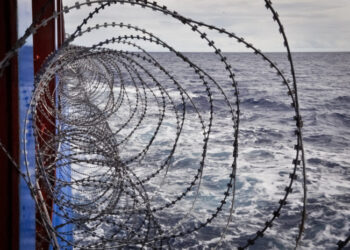Gard advises all vessels operating in the Gulf of Oman, Strait of Hormuz and Persian Gulf region to be highly alerted, operate with a heightened level of security and follow relevant guidance, as the tension in the area keep increasing.
According to Gard, all those sailing through the unsafe areas, should follow the relevant guidance provided by BMP5 and the Global Counter Piracy Guidance, including:
- register with the UKMTO when entering the Indian Ocean Voluntary Reporting Area (VRA);
- undertake a new ship and voyage specific threat risk assessment before entering any region where there has been an incident, or the threat level has changed, and review the Ship’s Security Plan;
- stay in close contact with ship’s agent and other local sources to obtain the most up to date and reliable information available at any given time;
otherwise comply with guidance provided by their Flag Administrations.
Many are the Flag Administrations that have increased the security level for the Gulf of Oman/Strait of Hormuz/Persian Gulf region:
- The Norwegian Maritime Authorities reaffirmed their previous instruction for Norwegian flagged ships arriving Strait of Hormuz within the boundaries of N25° – N28° and E054° – E058° to implement security measures as described in their SSP according to ISPS security level 2;
- The security level for British flagged ships have now been increased to level 3 in the Strait of Hormuz. In a letter to the United Nations Security Council dated 20 July 2019, the UK Department for Transport also states that it requests British flagged ships to avoid the Strait of Hormuz for an interim period until further notice.
In addition, OCIMF along with partners highlighted that the inshore traffic zone for navigation should be undertaken by the vessels that call at ports within the inshore area, because the risk of a collision would increase in the possibility that all vessels both inbound and outbound used the inshore traffic zone.
Moreover, Gard recommends that members and clients should also note the additional advice provided by OCIMF and INTERTANKO, proposing that ship operators send specific guidance to vessels.
Overall, there has been an increasing tension between the US and Iran, keeping in mind the attacks in Gulf of Oman that took place kept the industry alerted for additional attacks.
The situation got worse when the UK Royal Marines seized the Iranian ‘Grace 1’, near Gibraltar over suspected breach of EU sanctions earlier in July, and could only be released if the UK could guarantee the oil was not bound for Syria. Also, in June, the shipping industry was present in an additional attack that took place in the Gulf of Oman against two vessels. Yet, the first incident that spiked the tensions, was in May, when the UAE said that four vessels were sabotaged at the Fujairah port.
Concluding, the ongoing tensions in the area seem to be a challenge for the shipping industry to collaborate; Thus, Reuters provided a timeline of the events that feed the escalated tension among major state players, like US and Iran.






























































